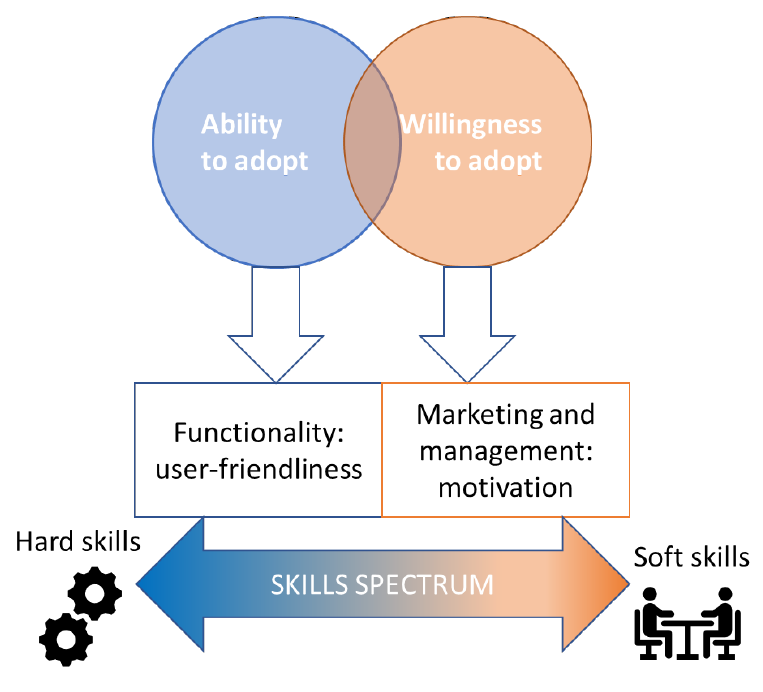Blockchain technology will be worth over US$175 billion by 2025, and in excess of US$3 trillion by 2030, according to the Australian Government’s National Blockchain Roadmap.
Australia must seize this opportunity to become a world-leader in digital technology and bolster the economy, but despite its potential, there is significant uncertainty regarding future adoption of blockchain technology locally.
CSIRO’s Data61 researchers have identified a particular set of workforce skills needed by the blockchain industry to give potential users the ability and the willingness to adopt blockchain technology and drive its development.
In a new research paper, titled Who is the Blockchain Employee? Exploring Skills in Demand using Observations from the Australian Labour Market and Behavioural Institutional Cryptoeconomics, Jessica Atherton, Dr Alexandra Bratanova and co-authors have used Australian labour market data to explore what skills and educational qualifications are in demand among the blockchain workforce.
What is blockchain?
Blockchains are a type of ‘distributed ledger’ technology, where a shared database (the ledger) is organised into a list of blocks. Additional blocks of data can only be added if a majority of independent nodes ‘agree’ that it is valid; if the new block is agreed to be valid, it is cryptographically ‘chained’ to the last block that was added, which was chained to the previous block, and so on, forming a blockchain.
As blocks are only added with the consensus of independent nodes, there is no single point where the blockchain’s data can be corrupted, meaning that unauthorised edits are significantly more difficult than with traditional ledgers, which can be edited by a single trusted authority.
In determining where we are now in the adoption of blockchain and what skills blockchain employees require, Ms Atherton and Dr Bratanova have used Australian labour market data from 2015-19 and the Gartner Hype Cycle for Emerging Technologies (Figure 1). According to the latter, sentiment is near the trough of disillusionment.
“Blockchain might hit the plateau of productivity within five to ten years,” Atherton explains. “But only if technology advancement continues rapidly, and if trust dramatically shifts away from centralised institutions in favour of decentralised blockchain systems.”
“However, it’s possible that blockchain will never reach the plateau of productivity if people and organisations don’t feel compelled to switch from existing systems to blockchain, or if technology fails to fulfill the expectations about its cost-effectiveness and technical performance at scale.”
How can we reach the plateau of productivity?
Job data analysed in this study revealed that the Australian blockchain industry is seeking employees who are highly educated, with a strong mix of soft and hard skills, as this will give users both the ability and the willingness to adopt blockchain – two critical needs that will allow the blockchain industry to build the expectations necessary to achieve mass blockchain adoption.
Hard skills, such as programming, computer science and user experience design, combined with soft skills, like teamwork, communication, institutional design and negotiation, were identified as essential to give users the ability to adopt blockchain.
To secure early adopters and build expectations, which will ultimately enable adoption willingness , skills such as leadership, strategic management and marketing expertise will be necessary in order to highlight how blockchain can solve real market problems and drive motivations to adoption.
“By having these skills involved in the development of blockchain technologies, we’ll start to see expectations rise in what blockchain is capable of, and more of a willingness to incorporate it into business activities. As per behavioural institutional cryptoeconomics, the more organisations expect others to get involved, the more likely they themselves are to get involved, leading to broad-scale adoption, and eventually economic gains.” - Data61 Research Scientist and paper co-author Dr Alexandra Bratanova
The research also identified that to increase adoption of blockchain technology, it is ideal to have adopters from multiple organisations or user groups to ensure the technology fulfills a market need. For example, a beef supply chain blockchain would benefit from adoption by cattle breeders, farmers, butchers, exporters, importers, government certifiers, retailers and consumers.
The future of blockchain looks bright - the labour market analysis here demonstrates that the blockchain industry in Australia is aware of the need for a mix of soft and hard skills, and is actively seeking and rewarding these skills. As we rise into the plateau of productivity, these skills will become even more valuable to organisations, who will benefit from their adoption of blockchain.
Key takeaways for organisations looking to develop blockchain technologies
- Blockchain leaders need to understand the opportunities and limitations of the technology in order to strategically develop,

Australian blockchain industry data market and manage blockchains as a software, as well as develop a population that can co-develop and use it.
- A multidisciplinary team will be critical to the success of a blockchain platform. Achieving mass blockchain adoption will require world class user experience design, so that the platform is user friendly.
- Institutional design skills (which can be gained from law, political science and economic degrees) and negotiation skills are necessary to set up an effective blockchain governance structure.
Key takeaways for those looking to enter a career in blockchain
- Labour market data shows that the blockchain workforce is in-demand, well compensated, experienced and highly educated, with a mix of hard software engineering skills and soft enterprise and personal skills.
- An aspiring developer likely already has strong technical skills, so expanding on softer skills such as collaboration, leadership, communication and design may be useful. An example of this would be to ensure you can concisely explain your work to co-workers who don’t come from computer science backgrounds, and explain the value of your work to customers.
